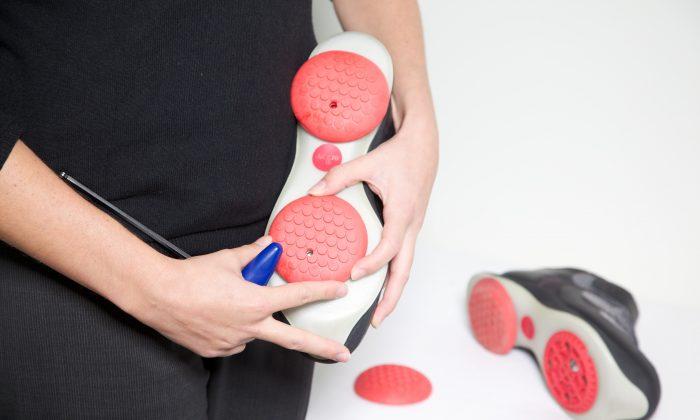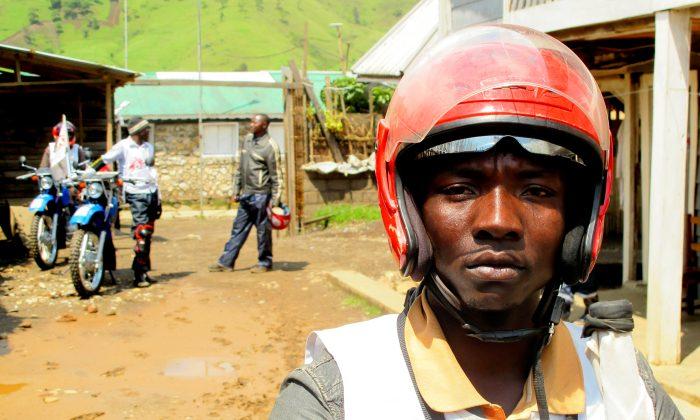COMMENT
For the past three months I have been striding around my home in a pair of what I can only describe as “wibbly wobbly” boots. They look like black high-top trainers, but if you check underneath, you can see two pods attached to the bottom of each boot. They’re very comfortable actually, and the reason I am wearing them every day, is that they are helping to reduce my chronic knee pain.
The boots are an integral part of a non-surgical, non-invasive method of improving knee function and reducing pain in people, who like me, have run out of options and would otherwise be heading for surgery. I’m in my mid-forties with young children and have osteoarthritis as result of a car accident 20 years ago. Suffering long-term knee pain has been debilitating and depressing at times. After five years of injections, painkillers, an arthroscopy and endless physiotherapy, what could I do except have surgery? But my consultant was adamant he would not operate, saying I was still too young for such major surgery. He spoke to me about AposTherapy, and referred me for a consultation.
What is AposTherapy?
So what is AposTherapy exactly and how does it work? I caught up with one of the co-inventors of the treatment, Israeli medical doctor and specialist in joint function and biomechanics, Dr Amit Mor.
“The science behind AposTherapy is very simple,” he explains. “A big part of any joint is the muscles that surround it and the nerves which dictate to the muscles what to do – we call it neuromuscular control. In any orthopaedic condition, be it knee pain or back pain, the muscles determine the function and the range of motion of the joint and when that begins to deteriorate, the muscles also lose control of the joint. They ‘brace’ the joint together instead of stabilising it and this is what we feel in back and knee pain – the muscles are bracing.
“This in turn leads to loss of control of muscles which then progresses to deformity in the joint, putting more pressure on it and ultimately leading to inflammation in the tendons and surrounding areas.
“Our treatment aims to rehabilitate the way muscles control the joint.”
Focus on rehabilitation
Dr Mor and Dr Avi Elbaz shared a passion for biomechanics when at medical school in the mid-90s. They both realised that nobody spoke about muscular skeletal problems, despite the evidence that they constitute the biggest problem in the western world.
In the UK, 1 per cent of GNP is spent on knee conditions, affecting 10 per cent of the population. In the United States, 7.4 per cent of GNP or one trillion dollars is spent on muscle and joint diseases. This is the biggest expenditure in medicine.
Both doctors decided that current treatments weren’t offering satisfactory long-term solutions. They firmly believed that the focus needed to shift from looking at X-rays and bones to looking at how to rehabilitate the muscles.
“We wanted to be able to deliver a treatment which would enable us to bring patients to a place where they are no longer in pain and no longer compensating,” Dr Mor tells me.
“People are living longer and are more active. You are 50 years young now and these baby-boomers want to carry on playing golf, or travelling, hiking and running. But so many people are suffering with knee and back pain, often using painkillers and injections to relieve the symptoms. Even following successful surgery, the need remains because people are often not well rehabilitated. They only go to the physiotherapist for a few sessions and don’t follow up properly.
Personalised treatment
“But with AposTherapy – (APOS - All Phases of Step Cycle) – you can bring the treatment into your own environment, your office, your home, wherever. Wearing the boots enables you to do hundreds of thousands of repetitions in an automatic manner, subconsciously as you go about your daily activities. This means you can comply with the treatment without effort.”
The initial consultation at the AposTherapy centre consists of an hour-and-a-half session. It includes a detailed questionnaire focusing on the nature of the pain, but also questions about your general health, well-being and quality of life.
A computer system measures the patient’s gait whilst walking along a rubber belt. Then you are ready to have the pods calibrated onto the soles of the boots by a specially trained physiotherapist.
“The boots are adjusted to alleviate the load from the damaged area and from the muscles, hence the pods,” Dr Mor explains. “This brings the joint and the whole body to a position where pain is reduced and people stop guarding or compensating. Then we want to bring the person into alignment. The boots and the pods introduce a very mild and controllable instability. As the patient walks, all the phases of step cycle, (apos) happens in a repetitive manner helping to re-teach the muscles how to stabilise the joint.”
Improved well-being
I’ve been wearing mine only a few months, but I notice a significant reduction in pain when I’m wearing the boots. I feel happier too, so it’s certainly affecting my well-being.
Dr Mor says it’s important to feel a reduction in pain as soon as the shoes are calibrated.
“The intention is to start teaching the muscles to begin stabilising the joints again. Normally there should be an improvement in function within four to eight months and in pain reduction in eight to twelve weeks,” he says.
I’m interested in the long-term findings of this treatment, which has now been around for about a decade. It’s currently available in the UK, Israel and Singapore. As of August it’ll be available in New York too. Up to now tens of thousands of people have been treated.
Encouraging research
Third party research by Network Research suggests AposTherapy can help reduce pain by approximately 60 per cent and function is improved by 60-65 per cent. Eighty-five per cent of people reported pain reduction within four to five weeks and 88 per cent reported improvements in the way they walked. A trial by BUPA healthcare in the UK reported a 95 per cent satisfaction rate with the treatment.
Dr Mor says, “We are a treatment aimed at reducing pain and improving function. We do not decide about surgery. That’s not our policy. If people come early on I believe they can avoid and delay surgery for many years. The later they come, they can still delay significantly. And importantly, the treatment can help with rehabilitation post-surgery too. We are seeing some fantastic results in rehab after joint replacement.”
A few months into my own treatment, I am noticing a reduction in pain when I wear the boots. It’s so easy to fit it into the day, I barely notice I’m wearing them and am prepared for the long haul to get my muscles rehabilitated for as long as possible.
To find out more visit: www.apostherapy.co.uk
Lorenza Bacino is a freelance features writer. She has contributed to The Guardian, The Independent and numerous other publications in the UK and abroad. Examples of her work can be found at www.cuttings.me/users/lorenzabacino
- BUPA healthcare offers AposTherapy treatment with various options. It covers the initial consultation plus two follow-up treatments. Packages are available to extend your treatment. Contact BUPA for further information
- If Apos decides you are not a suitable candidate for the therapy, the consultation is free of charge
- AposTherapy is available in the UK – London, Reading, Manchester, Birmingham and Edinburgh all have centres. For further details and addresses go to www.apostherapy.co.uk
- AposTherapy is available in Israel and Singapore too. It will be available in New York as of August 1st 2013
- AposTherapy can help reduce pain in a variety of conditions including osteo-arthritis, meniscal tears, back problems and ligament damage
- AposTherapy can help with rehabilitation following surgery





Friends Read Free